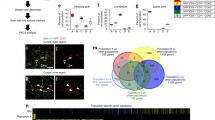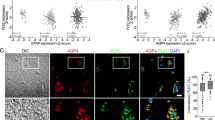Abstract
Glial fibrillary acidic protein (GFAP) is an astrocytic lineage-specific intermediate filament protein, and its expression or non-expression is inversely correlated with the tumourigenecity of astrocytoma cells. To estimate the GFAP levels of astrocytes in intracranial tumour tissues, we established primary cultures from six astrocytic tumour specimens and used a double-staining flow cytometric method to detect the different levels of GFAP among these primary cultures. Although these primary cultures exhibited the same Matrigel invasiveness, their GFAP expression is inversely related to the rate of cell growth and the histologic grade of the original tumour. Phenylacetate, 12-O-tetradecanoylphorbol-13-acetate (TPA) and sodium butyrate, which are potent inducers of differentiation in various cancer cells, have been examined for their effects on these primary cultures. Cytostasis was more or less caused by these compounds in all six primary cultures, but induction of GFAP was observed only in the primary culture derived from a less malignant astrocytoma specimen having the highest intrinsic GFAP level. Interestingly, this primary culture, but not others, also exhibited increased HRG-α expression after phenylacetate or sodium butyrate treatment. Loss of the inducibility of differentiation-related gene expression could be one of the events involved in the malignant progression of astrocytomas. In addition, the chemotherapeutic agent BiCNU has a killing effect on all six primary culture cells, with LD50 less than 60nM. The underlying mechanism was through the induction of apoptosis in these primary culture cells regardless of their varying malignancies of original tumours. However, unlike colon cancer and leukaemia cells, sodium butyrate could not induce apoptosis within 4 days in these astrocytic tumour cells, indicating that the cell context of different cell types indeed determined the ability of sodium butyrate to induce apoptosis.
Similar content being viewed by others
References
Lazarides E. Intermediate filaments: a chemically heterogeneous, developmentally regulated class of proteins. Ann Rev Biochem 1982; 51: 219–250.
Deck JHN, Eng LF, Bigbee J, Woodcock SM. The role of glial fibrillary acidic protein in the diagnosis of central nervous system tumors. Acta Neuropathol 1978; 42: 183–190.
Jacques CM, Turpin JC, Kujas M, Poreau A. GFA and S-100 protein levels as an index for malignancy in human gliomas and neurinomas. J Natl Cancer Inst 1979; 62: 479–483.
Duffy PE, Huang YY, Rapport MM. The relationship of glial fibrillary acidic protein to the shape, motility, and differentiation of human astrocytoma cells. Exp Cell Res 1982; 139: 145–157.
Eng LF, Rubinstein LJ. Contribution of immunohistochemistry to diagnostic problems of human cerebral tumors. J Histochem Cytochem 1978; 26: 513–522.
Velasco ME, Dahl D, Roessmann U, Gambetti P. Immunohistochemical localization of GFAP in human glial neoplasms. Cancer (Phila) 1980; 45: 484–493.
Rutka JT, Smith SL. Transfection of human astrocytoma cells with glial fibrillary acidic protein complementary DNA: Analysis of expression, proliferation, and tumorigenicity. Cancer Res 1993; 53: 3624–3631.
Rutka JT, Hubbard SL, Fukuyama K, Matsuzawa K, Dirks PB, Becker LE. Effects of antisense glial fibrillary acidic protein complementary DNA on the growth, invasion, and adhesion of human astrocytoma cells. Cancer Res 1994; 54: 3267–3272.
Samid D, Shack S, Sherman LT. Phenylacetate: A novel nontoxic inducer of tumor cell differentiation. Cancer Res 1992; 52: 1988–1992.
Samid D, Yeh A, Prasanna P. Induction of erythroid differentiation and fetal hemoglobin production in human leukemic cells treated with phenylacetate. Blood 1992; 80: 1576–1581.
Samid D, Shack S, Myers CE. Selective growth arrest and phenotypic reversion of prostate cancer cells in vitro by nontoxic pharmacological concentrations of phenylacetate. J Clin Invest 1993; 91: 2288–2295.
Samid D, Ram Z, Hudgins WR, et al. Selective activity of phenylacetate against malignant gliomas: resemblance to fetal brain damage in phenylketonuria. Cancer Res 1994; 54: 891–895.
Ram D, Samid D, Walbridge S, et al. Growth inhibition, tumor maturation, and extended survival in experimental brain tumors in rats treated with phenylacetate. Cancer Res 1994; 54: 2923–2927.
Thibault A, Samid D, Cooper MR, et al. Phase I study of phenylacetate administered twice daily to patients with cancer. Cancer (Phila) 1995; 75: 2932–2938.
Prasanna P, Shack S, Wilson VL, Samid D. Phenylacetate in chemoprevention: in vitro and in vivo suppression of 5-aza-2′-deoxycytidine-induced carcinogenesis. Clin Cancer Res 1995; 1: 865–871.
Berenblum I. The cocarcinogenic action of croton resin. Cancer Res 1941; 1: 44–48.
Driedger PE, Blumberg PM. Specific binding of phorbol ester tumor promoters. Proc Natl Acad Sci USA 1980; 77: 567–571.
Süss R, Kreibich G, Kinzel V. Phorbol esters as a tool in cell research? Eur J Cancer 1972; 8: 299–304.
Yasukawa M, Hato T, Inatsuki A, Kobayashi Y. Expression of CD9 (p24) antigen on hematopoietic cells following treatment with phorbol ester. Acta Haematol 1988; 79: 133–136.
Gescher A, Reed DJ. Characterization of the growth inhibition induced by tumor-promoting phorbol esters and of their receptor binding in A549 human lung carcinoma cells. Cancer Res 1985; 45: 4315–4321.
McBain JA, Pettit GR, Mueller GC. Bryostatin 1 antagonizes the terminal differentiating action of 12-O-tetradecanoylphorbol-13-acetate in a human colon cancer cell. Carcinogenesis 1988; 9: 123–129.
Huang TS, Duyster J, Wang JYJ. Biological response to phorbol ester determined by alternative G1 pathways. Proc Natl Acad Sci USA 1995; 92: 4793–4797.
Huang TS, Kuo ML, Shew JY, Chou YW, Yang WK. Distinct p53-mediated G1/S checkpoint responses in two NIH3T3 subclone cells following treatment with DNA-damaging agents. Oncogene 1996; 13: 625–632.
Frank DA, Sartorelli AC. Biochemical characterization of tyrosine kinase and phosphotyrosine phosphatase activity of HL-60 leukemia cells. Cancer Res 1988; 48: 4299–4306.
Kuo ML, Huang TS, Lin JK. Preferential requirement for protein tyrosine phosphatase activity in the 12-Otetradecanoylphorbol-13-acetate-induced differentiation of human colon cancer cells. Biochem Pharmacol 1995; 50: 1217–1222.
Roediger WE. Role of anaerobic bacteria in the metabolic welfare of the colonic mucosa in man. Gut 1980; 21: 793–798.
Cummings JH. Fermentation in the human large intestine: evidence and implications for health. Lancet 1983; 1: 1206–1209.
Newmark HL, Lupton JR, Young CW. Butyrate as a differentiating agent: pharmacokinetics, analogues and current status. Cancer Lett 1994; 78: 1–5.
Perrine SP, Rudolph A, Faller DV, et al. Butyrate infusions in the ovine fetus delay the biologic clock for globin gene switching. Proc Natl Acad Sci USA 1988; 85: 8540–8542.
Constantoulakis P, Knitter G, Stamatoyannopoulos G. On the induction of fetal hemoglobin by butyrates: in vivo and in vitro studies with sodium butyrate and comparison of combination treatments with 5-AzaC and AraC. Blood 1989; 74: 1963–1971.
Perrine SP, Miller BA, Faller DV, et al. Sodium butyrate enhances fetal globin gene expression in erythroid progenitors of patients with Hb SS and betathalassemia. Blood 1989; 74: 454–459.
Staiano-Coico L, McMahon CK, Pagan-Charry I, LaBruna A, Piraino V, Higgins PJ. Sodium-N-butyrate induces cytoskeletal rearrangements and formation of cornified envelopes in cultured adult human keratinocytes. Cell Tissue Kinet 1989; 22: 361–375.
Hague A, Manning AM, van-der-Stappen JW, Paraskeva C. Escape from negative regulation of growth by transforming growth factor beta and from the induction of apoptosis by the dietary agent sodium butyrate may be important in colorectal carcinogenesis. Cancer Metastasis Rev 1993; 12: 227–237.
Filippovich I, Sorokina N, Khanna KK, Lavin MF. Butyrate induced apoptosis in lymphoid cells preceded by transient over-expression of HSP70 mRNA. Biochem Biophys Res Commun 1994; 198: 257–265.
Buckley AR, Krumenacker JS, Buckley DJ, et al. Butyrate-induced reversal of dexamethasone resistance in autonomous rat Nb2 lymphoma cells. Apoptosis 1997; 2: 518–528.
Buckley AR, Leff MA, Buckley DJ, Magnuson NS, de Jong G, Gout PW. Alterations in pim-1 and c-myc expression associated with sodium butyrate-induced growth factor-dependency in autonomous rat Nb2 lymphoma cells. Cell Growth Diff 1996; 7: 1713–1721.
Boisteau O, Gautier F, Cordel S, et al. Apoptosis induced by sodium butyrate treatment increases immunogenicity of a rat colon tumor cell line. Apoptosis 1997; 2: 403–412.
Perrin P, Cassagnau E, Burg C, et al. An interleukin-2/ sodium butyrate combination as immunotherapy for rat colon cancer peritoneal carcinomatosis. Gastroenterology 1994; 107: 1697–1708.
Huang TS, Shu CH, Shih YL, et al. Protein tyrosine phosphatase activities are involved in apoptotic cancer cell death induced by GL331, a new homolog of etoposide. Cancer Lett 1996; 110: 77–85.
Huang TS, Shu CH, Yang WK, Whang-Peng J. Activation of CDC 25 phosphatase and CDC 2 kinase involved in GL331-induced apoptosis. Cancer Res 1997; 57: 2974–2978.
Albini A, Iwamoto Y, Kleinman HK, et al. A rapid in vitro assay for quantitating the invasive potential of tumor cells. Cancer Res 1987; 47: 3239–3245.
Huang TS, Yang WK, Whang-Peng J. GL331-induced disruption of cyclin B1/CDC 2 complex and inhibition of CDC 2 kinase activity. Apoptosis 1996; 1: 213–217.
Ahmed SA, Gogal RM Jr, Walsh JE. A new rapid and simple non-radioactive assay to monitor and determine the proliferation of lymphocytes: an alternative to 3 Hthymidine incorporation assay. J Immunol Methods 1994; 170: 211–224.
Shu CH, Yang WK, Huang TS. Increased cyclin B1/ CDC 2 kinase activity and phosphorylation of Bcl-2 associated with paclitaxel-induced apoptosis in human nasopharyngeal carcinoma cells. Apoptosis 1996; 1: 141–146.
Holmes WE, Sliwkowski MX, Akita RW, et al. Identification of heregulin, a specific activator of p185erbB2. Science 1992; 256: 1205–1210.
Marchionni MA, Goodearl ADJ, Chen MS, et al. Glial growth factors are alternatively spliced erbB2 ligands expressed in the nervous system. Nature 1993; 362: 312–318.
Reeves SA, Helman LJ, Allison A, Israel MA. Molecular cloning and primary structure of human glial fibrillary acidic protein. Proc Natl Acad Sci USA 1989; 86: 5178–5182.
Bongcam-Rudloff E, Nistêr M, Betsholtz C, et al. Human glial fibrillary acidic protein: complementary DNA cloning, chromosome localization, and messenger RNA expression in human glioma cell lines of various phenotypes. Cancer Res 1991; 51: 1553–1560.
Weinstein DE, Shelanski ML, Liem RKH. Suppression by antisense mRNA demonstrates a requirement for the glial fibrillary acidic protein in the formation of stable astrocytic processes in response to neurons. J Cell Biol 1991; 112: 1205–1213.
Matsuoka Y, Nishizawa K, Yano T, et al. Two different protein kinases act on a different time schedule as glial filament kinases during mitosis. EMBO J 1992; 11: 2895–2902.
Inagaki M, Gonda Y, Nishizawa K, et al. Phosphorylation sites linked to glial filament disassembly in vitro locate in a non-a-helical head domain. J Biol Chem 1990; 265: 4722–4729.
Tsujimura K, Tanaka J, Ando S, et al. Identification of phosphorylation sites on glial fibrillary acidic protein for cdc2 kinase and Ca2+-calmodulin-dependent protein kinase II. J Biochem 1994; 116: 426–434.
Steinert PM, Roop DR. Molecular and cellular biology of the intermediate filaments. Ann Rev Biochem 1988; 57: 593–625.
Collins VP, James CD. Gene and chromosomal alterations associated with the development of human gliomas. FASEB J 1993; 7: 926–930.
Rights and permissions
About this article
Cite this article
Chen, MH., Yang, W.K., Whang-Peng, J. et al. Differential inducibilities of GFAP expression, cytostasis and apoptosis in primary cultures of human astrocytic tumours. Apoptosis 3, 171–182 (1998). https://doi.org/10.1023/A:1009698822305
Issue Date:
DOI: https://doi.org/10.1023/A:1009698822305




